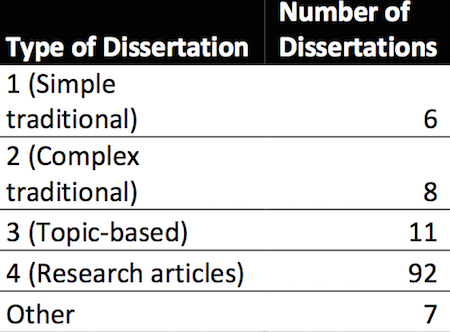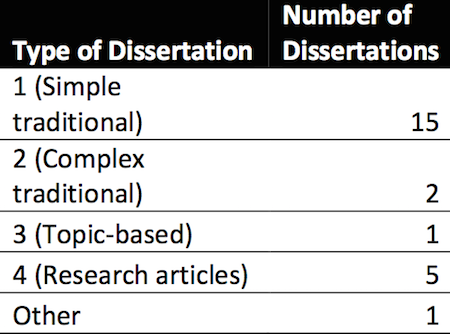You have /5 articles left.
Sign up for a free account or log in.
Not every dissertation has to be a monograph. That’s what disciplinary associations in the humanities have been saying for years, as they advocate for a broader definition of what constitutes the doctoral capstone.
But what about the natural sciences? New research from North Carolina State University suggests that math- and science-oriented institutions are seeing a big shift toward article-style dissertations, and that the trend is likely to continue.
“The most popular type of dissertation at [North Carolina State] is the research article dissertation,” now the most likely dissertation style for students in seven of 10 colleges on campus, reads a working paper to be discussed this week at the Council of Writing Program Administrators’ annual meeting in Raleigh, N.C. “We see this as a positive development in doctoral research; for students pursuing academic jobs, they are aligning their educational pursuits with their future professional requirements.”
Such dissertations also contribute to the research productivity of the university, the paper notes.
“Dissertations at N.C. State University: A Guide to Understanding What Dissertations Look Like” was written by Meagan Kittle Autry, director of thesis and dissertation support services, and Karissa Wojcik, a graduate assistant. Kittle Autry said it had been well over a decade since the last large-scale study of dissertation styles at a STEM university, and a new review was necessary to give current Ph.D. students personalized advice about how to approach their projects.
That last study suggested very few students were writing research article-style dissertations, Kittle Autry said. With graduate school's increasingly professional orientation and increased pressure to publish, had anything changed?
For their paper, Kittle Autry and Wojcik studied about 400 dissertations by North Carolina State Ph.D. candidates submitted in 2014 and 2015. They sorted each into one of four major dissertation styles:
- Simple traditional dissertation, including an introduction, literature review, methods, results and discussion.
- Complex traditional dissertation, similar to above but reporting on more than one study.
- Topic-based dissertation, in which topical chapters follow an introduction. It’s the most varied dissertation type in structure, and is more common in nonempirical research fields.
- Research article dissertation, or chapter-length research articles often bookended by an introduction, conclusion and literature review.
The majority of dissertations (65 percent) turned out to be research article based. Only two of 10 colleges -- those for design and education, respectively -- saw no such dissertations. All of the dissertations in the College of Veterinary Medicine were research articles.
Simple traditional was the second most common dissertation type in the sample, at 20 percent. Topic-based dissertations were the third most popular, with many clustered in engineering and the sciences.
Complex traditional dissertations were the least popular.
Here’s how engineering fared:

Because North Carolina State is a science, technology, engineering and math-oriented institution, humanities and social science dissertations made up a relatively small portion of the sample. But, for purposes of comparison, here’s a breakdown of dissertations in the College of Humanities and Social Sciences:

Kittle Autry and colleagues have gathered additional data to suggest that what's happening at North Carolina State is part of a national trend; they plan to present it at the meeting this week. Over all, Kittle Autry said the single-campus study provides empirical evidence “of what we have recently been identifying as the increased professionalization of the Ph.D. … Basically, if you are a graduate student in one of those disciplines, as well as many others -- psychology, veterinary medicine, natural resources, textiles -- you should expect to produce a research article dissertation.”
As for whether the trend originated in the humanities or sciences, or both, Kittle Autry said that STEM fields have been quietly moving in this direction for some 20 years. While the humanities fields are better “about talking writing than STEM fields,” she said, “that hasn't necessarily translated into the same type of movement away from monographs for dissertations.”
Kittle Autry attributed that idea to the nature of natural scientists’ and engineers’ work. That is, they’ll be primarily writing research articles, while there’s still an expectation for humanists to write books to earn tenure.
Yet because many humanities Ph.D.s won’t earn tenure, she said, reimagining the humanities dissertation still makes sense.





